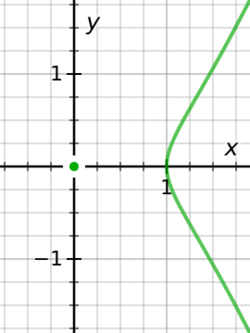Acnode
An acnode is an isolated point in the solution set of a polynomial equation in two real variables. Equivalent terms are isolated point and hermit point.[1]
For example the equation
- [math]\displaystyle{ f(x,y)=y^2+x^2-x^3=0 }[/math]
has an acnode at the origin, because it is equivalent to
- [math]\displaystyle{ y^2 = x^2 (x-1) }[/math]
and [math]\displaystyle{ x^2(x-1) }[/math] is non-negative only when [math]\displaystyle{ x }[/math] ≥ 1 or [math]\displaystyle{ x = 0 }[/math]. Thus, over the real numbers the equation has no solutions for [math]\displaystyle{ x \lt 1 }[/math] except for (0, 0).
In contrast, over the complex numbers the origin is not isolated since square roots of negative real numbers exist. In fact, the complex solution set of a polynomial equation in two complex variables can never have an isolated point.
An acnode is a critical point, or singularity, of the defining polynomial function, in the sense that both partial derivatives [math]\displaystyle{ \partial f\over \partial x }[/math] and [math]\displaystyle{ \partial f\over \partial y }[/math] vanish. Further the Hessian matrix of second derivatives will be positive definite or negative definite, since the function must have a local minimum or a local maximum at the singularity.
See also
References
- ↑ Hazewinkel, Michiel, ed. (2001), "Acnode", Encyclopedia of Mathematics, Springer Science+Business Media B.V. / Kluwer Academic Publishers, ISBN 978-1-55608-010-4, https://www.encyclopediaofmath.org/index.php?title=Acnode
- Porteous, Ian (1994). Geometric Differentiation. Cambridge University Press. ISBN 978-0-521-39063-7. https://archive.org/details/geometricdiffere0000port.
es:Punto singular de una curva#Acnodos
 |


